 Yueyang Tower
Yueyang Tower, also called Yueyang Pavilion, is standing at the western gate of Yueyang Ancient City, Hunan Province, overlooking Lake Dongting from its perch on the eastern shore of the lake. And it is the central attraction in Yueyang City, given its cultural history and its fame as one of the three famous towers of Southern China, the other two being
Yellow Crane Tower in Wuhan, Hubei Province and
Prince Teng Pavilion in Nanchang, Jiangxi Province.
Legend & History During the Tang Dynasty (618-907), the tower was rebuilt by the then governor of Yueyang, Zhang Shuo, who had held a higher office at the Tang court but was demoted and banished to Yueyang to serve as governor there. It was at this time that the tower was renamed to Yueyang Tower.
During the Song (960-1279) Dynasty, the governor of Yueyang, Teng Zijing, invited a friend and former chancellor Fan Zhongyan to write an essay honoring the tower. The result was the famous "Memorial to Yueyang Pavilion", the most famous line of which was the admonition to those fighting for social justice to "be the first to show concern about the nation's problems, the last to rejoice when those problems are declared resolved" (or the last to declare "mission accomplished", if you will – go here to learn more about Yueyang Tower).
What to see?
In January 1988, Yueyang Tower was identified as a national key cultural relics protection unit by the State Council of China.On January 11, 2001, the Yueyang Tower Scenic Area was rated as an AAAA tourist area by the China National Tourism Administration. In September 2011, Yueyang Tower-Junshan Island Scenic Area was approved as a national 5A-level tourist area.
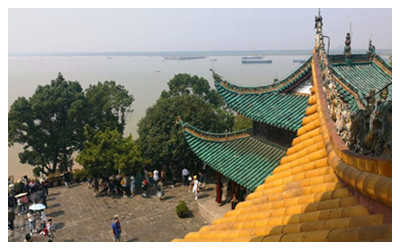 Yueyang Tower
Yueyang Tower
Yueyang Tower stands close to Dongting Lake, facing Junshan Isle with the city behind. The main tower, 19 meters high, is a three-story structure supported by four pillars and made of pure wood and upturned eaves. Yueyang Tower
has a unique architectural structure. Especially noteworthy is the tower top which resembles a helmet used by warriors in ancient times, a real rarity in the history of ancient Chinese architecture. The structure is a unique combination of artistic tastes, mechanics, architecture, and craftsmanship. The Tower affords a spectacular view of Dongting Lake.
Xianmei Pavilion
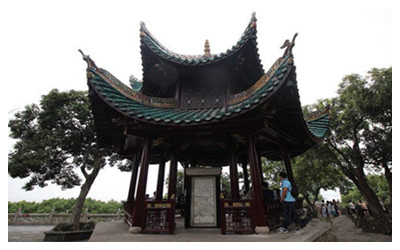
It is also called Fairy Plum Pavilion. Corresponding to the Three Drunk Pavilion, it is located on the south side of Yueyang Tower. As one of the three auxiliary pavilions of the main building of Yueyang Tower, the
Xianmei Pavilion is a small wood -structure pavilion with a hexagonal shape, two floors and three eaves, high eaves angle, and elegant elegance. Covered with green glazed tiles, the pavilion is 7 meters high. It was built in 1639 ( the 12th year of Ming Dynasty 's Empeor Chongzhen). According to the legend, in that year, Tao Zongkong, the official in charge of Yuezhou County, presided over the reconstruction of Yueyang Tower. He obtained a stone from the sand-stone of the building foundation, then removed its muddy water, the stone showed a branch with twenty-four dead plum blossoms. At that time, people thought it was a fetish and called it "fairy plum". So he built a pavilion here, and put the stone in it, named the pavilion "Xianmei Pavilion". or "Fairy Plum Pavilion". In 1775 ( the 40 years of the Qing Dynasty's Emoeror Qianlong ), the pavilion was rebuilt on the former site by Xiong Yingjiang, the former county governor of Yuezhou County, while he rebuilt the Yueyang Tower at that time.
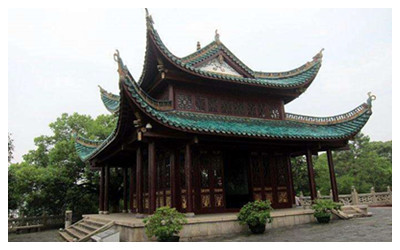 Sanzui Pavilion
Sanzui Pavilion
Known as the Three Drunk Pavilion, It is located on the north side of Yueyang Tower and echoes the Xianmei Pavilion
Yao on the south side of Yueyang Tower. It was built in the forty years of the Qing Emperor Qianlong (1775). In the 19th year of Qing Dynasty's Emperor Daoguang (1839), it was rebuilt and renamed Doumak. Qing Dynasty's Emperor Tongzhi three years (1864) was rebuilt again and renamed according to the legendary story about Lu
Dongbin once drunk three times in Yueyang Tower. The Sanzui Pavilion you see today was rebuilt in 1977. It is 9 meters high and is also a wooden structure like Yueyang Tower.
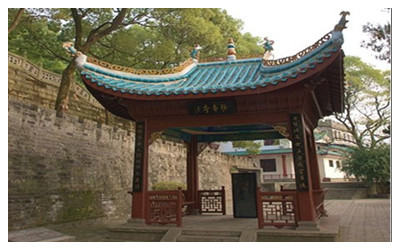 Huaifu Pavilion
Huaifu Pavilion
It is also called the Du Fu Memorial Pavilion. Covering an area of 40 square meters, Huaifu Pavilion is 7 meters high. There four large pillars made of cement are surrounded by railings. The upper part of the pavilion is made of wood. In the pavilion, there is a stone tablet. On the front of the stone tablet, it is engraved with Du Fu's portrait and his poem "Climb Yueyang Tower". On the back, it is engraved with his life stories. Du Fu, one of the top famous poets in the Tang Dynasty(618-907), once exiled in Baling ( today's Yueyang). Although he was impoverished, he left his descendants with immortal poems such as "Climb Yueyang Tower".Later, he died in Yueyang. In 1962, Du fu was proclaimed as one of the "four major cultural celebrities in the world." by the World Peace Council so as to commemorate the 1250th anniversary of the birth of the great poet Du Fu of the Tang Dynasty. And the Yueyang people built this pavilion in memory of Du Fu on the south side of the platform facing the lake under the Yueyang Tower.
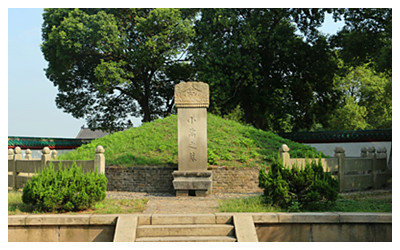
Xiao Qiao's Tomb is located at about 200 meters north of Yueyang Tower. Legend has it that it was the back garden of governor's office of Zhou Yu, husband of Xiao Qiao as well as a famous general of Wu Kingdom during the Three Kingdoms Dynasty. There is a statue of Xiao Qiao in the ancestral hall which is a courtyard structure.
Xiao Qiao was the wife of Zhou Yu during the Three Kingdoms Period. Xiao Qiao was a famous preety girl in that time. After Zhou Yu's death, she was here with her son, and was later buried here.
Lu Su's Tomb
Lu Su's Tomb lies 600 meters east of
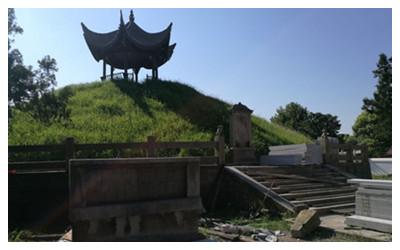
Yueyang Tower Scenic Area. Walking 150 meters south from an alley on 3517 Road, you can see it lying at the intersection. The tomb is towering like a mound, surrounded by stone fences, and there is a small pavilion on the top of the tomb. Inside the pavilion, there is a two-meter-high stone stele carved in the late Qing Dynasty(1645-1911) . According to legend, during the period of the Three Kingdoms, after Zhou Yu died, Lu Su acted as the superintendent of the water army. He stationed in Yueyang and trained the water army in
Dongting Lake, He once personally went to
Changde to negotiate with Guan Yu, a general of Shu Kingdom during the Three Kingdoms Period. They demarcated the Xiangjiang River, and the Three kingdoms (Wei,Shu,Wu) became a tribe. Lu Su was buried here after he died Yue Yang.
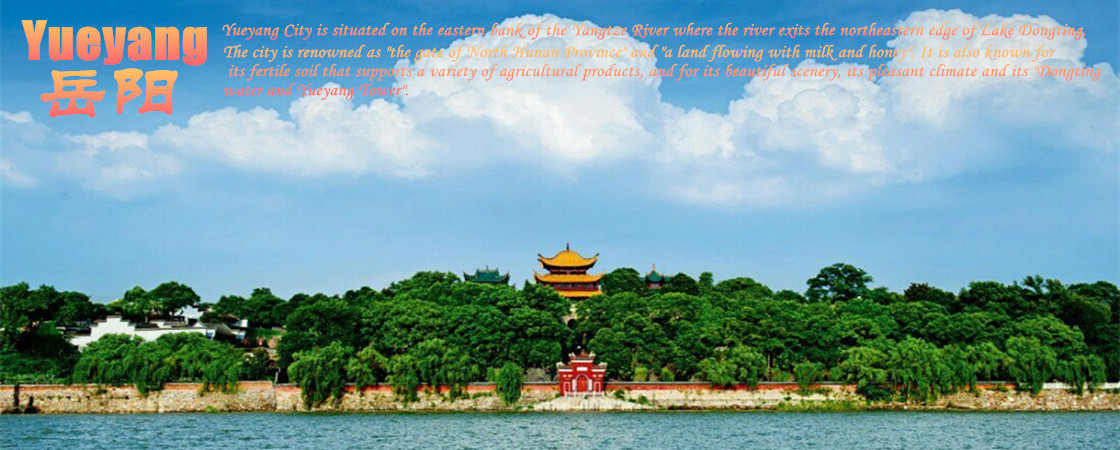
 Yueyang Tower, also called Yueyang Pavilion, is standing at the western gate of Yueyang Ancient City, Hunan Province, overlooking Lake Dongting from its perch on the eastern shore of the lake. And it is the central attraction in Yueyang City, given its cultural history and its fame as one of the three famous towers of Southern China, the other two being Yellow Crane Tower in Wuhan, Hubei Province and Prince Teng Pavilion in Nanchang, Jiangxi Province.
Yueyang Tower, also called Yueyang Pavilion, is standing at the western gate of Yueyang Ancient City, Hunan Province, overlooking Lake Dongting from its perch on the eastern shore of the lake. And it is the central attraction in Yueyang City, given its cultural history and its fame as one of the three famous towers of Southern China, the other two being Yellow Crane Tower in Wuhan, Hubei Province and Prince Teng Pavilion in Nanchang, Jiangxi Province.  Yueyang Tower
Yueyang Tower It is also called Fairy Plum Pavilion. Corresponding to the Three Drunk Pavilion, it is located on the south side of Yueyang Tower. As one of the three auxiliary pavilions of the main building of Yueyang Tower, the Xianmei Pavilion is a small wood -structure pavilion with a hexagonal shape, two floors and three eaves, high eaves angle, and elegant elegance. Covered with green glazed tiles, the pavilion is 7 meters high. It was built in 1639 ( the 12th year of Ming Dynasty 's Empeor Chongzhen). According to the legend, in that year, Tao Zongkong, the official in charge of Yuezhou County, presided over the reconstruction of Yueyang Tower. He obtained a stone from the sand-stone of the building foundation, then removed its muddy water, the stone showed a branch with twenty-four dead plum blossoms. At that time, people thought it was a fetish and called it "fairy plum". So he built a pavilion here, and put the stone in it, named the pavilion "Xianmei Pavilion". or "Fairy Plum Pavilion". In 1775 ( the 40 years of the Qing Dynasty's Emoeror Qianlong ), the pavilion was rebuilt on the former site by Xiong Yingjiang, the former county governor of Yuezhou County, while he rebuilt the Yueyang Tower at that time.
It is also called Fairy Plum Pavilion. Corresponding to the Three Drunk Pavilion, it is located on the south side of Yueyang Tower. As one of the three auxiliary pavilions of the main building of Yueyang Tower, the Xianmei Pavilion is a small wood -structure pavilion with a hexagonal shape, two floors and three eaves, high eaves angle, and elegant elegance. Covered with green glazed tiles, the pavilion is 7 meters high. It was built in 1639 ( the 12th year of Ming Dynasty 's Empeor Chongzhen). According to the legend, in that year, Tao Zongkong, the official in charge of Yuezhou County, presided over the reconstruction of Yueyang Tower. He obtained a stone from the sand-stone of the building foundation, then removed its muddy water, the stone showed a branch with twenty-four dead plum blossoms. At that time, people thought it was a fetish and called it "fairy plum". So he built a pavilion here, and put the stone in it, named the pavilion "Xianmei Pavilion". or "Fairy Plum Pavilion". In 1775 ( the 40 years of the Qing Dynasty's Emoeror Qianlong ), the pavilion was rebuilt on the former site by Xiong Yingjiang, the former county governor of Yuezhou County, while he rebuilt the Yueyang Tower at that time.  Sanzui Pavilion
Sanzui Pavilion
 Huaifu Pavilion
Huaifu Pavilion Xiao Qiao's Tomb is located at about 200 meters north of Yueyang Tower. Legend has it that it was the back garden of governor's office of Zhou Yu, husband of Xiao Qiao as well as a famous general of Wu Kingdom during the Three Kingdoms Dynasty. There is a statue of Xiao Qiao in the ancestral hall which is a courtyard structure.
Xiao Qiao's Tomb is located at about 200 meters north of Yueyang Tower. Legend has it that it was the back garden of governor's office of Zhou Yu, husband of Xiao Qiao as well as a famous general of Wu Kingdom during the Three Kingdoms Dynasty. There is a statue of Xiao Qiao in the ancestral hall which is a courtyard structure. Yueyang Tower Scenic Area. Walking 150 meters south from an alley on 3517 Road, you can see it lying at the intersection. The tomb is towering like a mound, surrounded by stone fences, and there is a small pavilion on the top of the tomb. Inside the pavilion, there is a two-meter-high stone stele carved in the late Qing Dynasty(1645-1911) . According to legend, during the period of the Three Kingdoms, after Zhou Yu died, Lu Su acted as the superintendent of the water army. He stationed in Yueyang and trained the water army in Dongting Lake, He once personally went to Changde to negotiate with Guan Yu, a general of Shu Kingdom during the Three Kingdoms Period. They demarcated the Xiangjiang River, and the Three kingdoms (Wei,Shu,Wu) became a tribe. Lu Su was buried here after he died Yue Yang.
Yueyang Tower Scenic Area. Walking 150 meters south from an alley on 3517 Road, you can see it lying at the intersection. The tomb is towering like a mound, surrounded by stone fences, and there is a small pavilion on the top of the tomb. Inside the pavilion, there is a two-meter-high stone stele carved in the late Qing Dynasty(1645-1911) . According to legend, during the period of the Three Kingdoms, after Zhou Yu died, Lu Su acted as the superintendent of the water army. He stationed in Yueyang and trained the water army in Dongting Lake, He once personally went to Changde to negotiate with Guan Yu, a general of Shu Kingdom during the Three Kingdoms Period. They demarcated the Xiangjiang River, and the Three kingdoms (Wei,Shu,Wu) became a tribe. Lu Su was buried here after he died Yue Yang. Ask Questions ?
Ask Questions ?